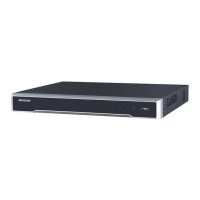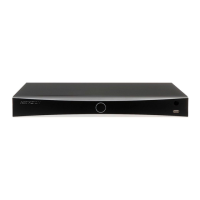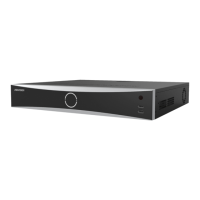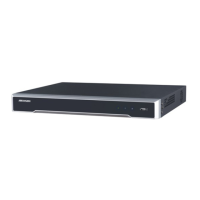
Do you have a question about the HIKVISION DS-7608NI-SE/P and is the answer not in the manual?
| Brand | HIKVISION |
|---|---|
| Model | DS-7608NI-SE/P |
| Category | Network Hardware |
| Language | English |
Description of the control panel buttons for different NVR models, including HDD/HDD2, panel lock, and status indicators.
Details on using the included IR remote control for NVR operations, including key functions and troubleshooting.
Instructions for using a standard 3-button USB mouse with the NVR for navigation and control.
Explanation of the soft keyboard layout and button functions used for inputting text and data.
Overview of rear panel interfaces and connectors for various NVR models, including power, audio, HDMI, VGA, and network ports.
Procedures for properly starting up and shutting down the NVR to ensure device longevity and system integrity.
Guide on setting a strong administrator password for initial device activation and security.
Step-by-step instructions for using the setup wizard to configure essential NVR settings like date, time, and network.
Procedures for logging into and out of the NVR system, including user account protection.
Detailed guide on activating IP cameras and adding them to the NVR for live view and recording.
Overview of the Live View mode, which displays real-time video from cameras, and description of live view icons.
Explanation of various operations available in Live View mode, including single screen, multi-screen, and auto-switch.
Guide on customizing Live View settings such as output interface, dwell time, audio, and camera order.
Procedure for logging out of the NVR system, returning the interface to live view mode.
Instructions for setting up PTZ parameters, including RS-485 settings, for controlling PTZ cameras.
Guide on setting and calling PTZ presets, patrols, and patterns for automated camera movements.
Overview of the PTZ control panel interface and its icons for managing PTZ camera functions.
Details on configuring recording parameters like stream type, resolution, pre-record, and post-record.
Instructions for setting up recording schedules for cameras, defining recording types and time periods.
Guide on setting up motion detection parameters, areas, sensitivity, and response actions for recording.
Instructions for configuring recording triggered by alarm inputs, including alarm parameters and linkage.
Guide on setting up recording triggered by VCA (Video Content Analysis) alarms and configuring response actions.
Procedure for enabling and disabling manual recording, which takes priority over scheduled recording.
Instructions for setting up special recording schedules for holidays, allowing different recording plans.
Guide on enabling redundant recording to save files on both R/W and redundant HDDs for enhanced data safety.
Instructions for grouping HDDs and assigning channels to specific HDD groups for organized storage.
Methods for protecting recorded files by locking them or setting HDD property to Read-only.
Detailed guide on playing back recorded video files by channel, time, event search, tags, and smart playback.
Explanation of auxiliary playback functions like frame-by-frame playback, digital zoom, and multi-channel reverse playback.
Instructions for backing up record files using quick export, normal video search, event search, and video clips.
Guide on managing backup devices like USB flash drives, HDDs, writers, and CD/DVD-RW.
Configuration of motion detection parameters, including area, sensitivity, and alarm response actions.
Guide on setting up handling actions for external sensor alarms, including trigger channels and arming schedules.
Setup for detecting video loss from a channel and configuring associated alarm response actions.
Configuration for detecting video tampering, setting sensitivity, areas, and alarm response actions.
Guide on configuring VCA alarms, including enabling, setting response actions, and arming schedules.
Settings for handling various system exceptions like HDD full, network errors, and illegal logins.
Configuration of actions taken upon alarm or exception events, such as event hints, full screen monitoring, and audible warnings.
Procedure for manually triggering or clearing alarm outputs for specific alarm outputs.
Guide to configuring general network settings like IP address, gateway, DNS, and working mode.
Details on advanced network configurations including EZVIZ Cloud P2P, DDNS, PPPoE, NTP, SNMP, and Remote Alarm Host.
Instructions for checking real-time network traffic information, including linking status and bandwidth.
Guide on network detection functions, including testing delay/packet loss and exporting network packets.
Procedure for initializing newly installed HDDs before they can be used with the NVR.
Guide on adding and configuring NAS or IP SAN disks as network HDDs for storage expansion.
Instructions for managing HDDs in groups and setting HDD properties like redundancy or read-only.
Guide on configuring quota mode to allocate specific storage capacity to each camera for recorded files.
Methods for checking the status of installed HDDs, including through HDD Information and System Information interfaces.
Explanation of HDD detection functions like S.M.A.R.T. and Bad Sector Detection for monitoring HDD reliability.
Guide on configuring alarms for HDD errors, including exception types and alarm response actions.
Instructions for configuring OSD (On-screen Display) settings for cameras, including date/time and camera name.
Guide on setting up privacy mask zones to block specific areas from being viewed or recorded by the operator.
Instructions for adjusting video parameters such as brightness, contrast, saturation, and hue for cameras.
Guide on viewing system information of the NVR, including device, camera, record, alarm, network, and HDD details.
Instructions for searching, viewing, and exporting log files, including operation, alarm, and exception records.
Guide on importing and exporting IP camera information, useful for backing up or configuring multiple NVRs.
Instructions for exporting NVR configuration for backup and importing it to multiple NVR devices for consistent setup.
Procedures for upgrading the NVR system firmware using a local backup device or a remote FTP server.
Guide on restoring NVR settings to factory defaults, including full restore or network-only restore.
Instructions for configuring the RS-232 serial port for parameter configuration or transparent channel communication.
Guide on configuring general settings like language, resolution, time zone, and date/time formats.
Instructions for configuring Daylight Saving Time (DST) settings, including auto adjustment and manual dates.
Guide on configuring additional device parameters like device name, number, auto logout, and menu output mode.
Instructions for managing user accounts, including adding, deleting, editing users, and setting permissions.
Definitions of technical terms and acronyms used throughout the NVR user manual.
Solutions for common issues encountered with the NVR, including display, audio, network, and playback problems.
Overview of updates and new features introduced in different software versions of the NVR.
A comprehensive list of compatible IP cameras, including model, version, and feature support.
A specific list of Hikvision IP cameras compatible with the NVR, detailing model and specifications.
A list of third-party IP cameras that are compatible with the NVR, specifying protocol support.











